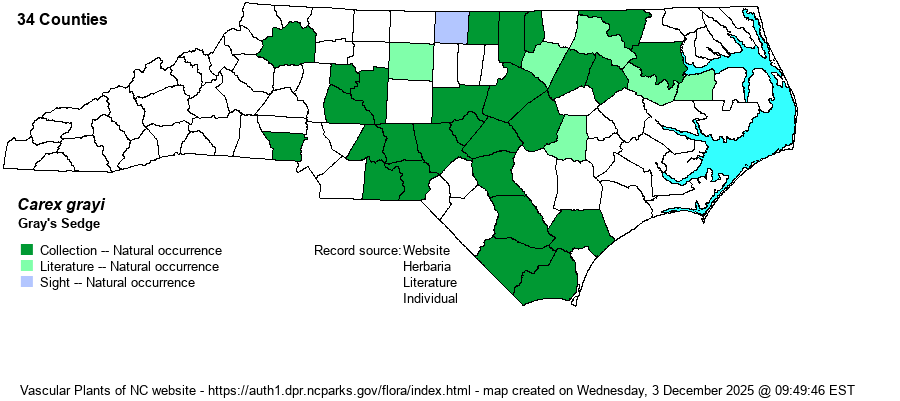| Author | Carey | |
| Distribution | Piedmont and inner Coastal Plain, extending down the Cape Fear River to Brunswick County, and down the Roanoke River to Bertie County. Gaps in the Piedmont and upper Coastal Plain are puzzling -- especially in heavily collected counties such as Durham, Orange, Rockingham, Mecklenburg, Halifax, and others that have seemingly suitable habitat.
Southern Que. to WI and IA, south to northern GA and OK; disjunct to northwestern FL. | |
| Abundance | Frequent -- though seemingly a bit local -- in the lower and middle Piedmont and inner Coastal Plain; rare elsewhere in these two provinces. Absent in the Mountains. Plants are often locally abundant (dominant), but may also vary to merely uncommon. | |
| Habitat | Floodplain forests of brownwater rivers, usually occupying the lower terrace in rich alluvial soil. |
| Phenology | Flowering and fruiting May-July. | |
| Identification | In Gray's Sedge each head of the inflorescence is round and spikey, like a medieval mace or like a tiny Sweetgum (Liquidambar styraciflua) "ball". Carex intumescens looks very similar, but the heads are not as round (more often obovoid or ovoid) and have fewer perigynia (1-12 vs. 8-35 in C. grayi). | |
| Taxonomic Comments | None
The genus Carex is the largest in North America, and among the largest in the world. In temperate and boreal regions, Carex is often the dominant or co-dominant ground layer in many habitats. Seeds (achenes) are valuable food for birds and small mammals, while foliage is used by birds and mammals to make nests and as food by mammals. Species of Carex often look vastly different from one another -- spikes erect vs. drooping, tiny inflorescence vs. whopping, culms leafy vs. naked, perigynia beaked vs. beakless, stems densely bunched vs. single, etc. The genus has been divided into many sections (or groups), based on shared characters; some taxonomists have suggested that these be different genera, but that proves unworkable (so far). All Carex share the feature of a perigynium (an outer covering) which completely surrounds the achene (seed). This covering may fit tightly or loosely (like a small bladder), depending on which group or species. Details of perigynia shape, ornamentation, presence and size of beak, number of striations (or veins) are all important ID features. In recent years Rob Naczi and colleagues have stressed the importance of arrangement of perigynia -- whether spiral (3+ ranks) or distichous (2-ranked) -- and have named a number of new species as well as split off some older synonyms. Therefore, RAB's (1968) key, excellent for its time, can only be used in a general way today. Members of some sections of Carex are difficult to key out (notably Ovales, Laxiflorae, Griseae); this is in part due to variation among individuals of a species, or failings of the key. FNA has drawings of most species and some species may be found in two or more places within a key, to acount for variability. New species to NC, and new to science(!), continue to be found in NC. | |
| Other Common Name(s) | Common Bur Sedge, Bur Sedge, Mace Sedge, Asa Gray's Sedge | |
| State Rank | S3? [S4] | |
| Global Rank | G4 | |
| State Status | | |
| US Status | | |
| USACE-agcp | FACW link |
| USACE-emp | FACW link |

